Students can access the CBSE Sample Papers for Class 11 Biology with Solutions and marking scheme Term 2 Set 4 will help students in understanding the difficulty level of the exam.
CBSE Sample Papers for Class 11 Biology Term 2 Set 4 for Practice
Time : 2 Hours
Maximum Marks : 35
General Instructions:
- All questions are compulsory.
- The question paper has three sections of 23 questions. All questions are compulsory.
- Section-A has 6 questions of 2 marks each; Sedion-B has 6 questions of 3 marks each, and Section-C has a case-based question of 5 marks.
- There is no overall choice. However, internal choices have been provided in some questions. A student has to attempt only one of the alternatives in such questions.
- Wherever necessary, neat and properly labeled diagrams should be drawn.
![]()
Section – A
(2 Marks each)
Question 1.
Certain plants growing in the tropical regions suffer from photorespiratory loss.
(a) How do they overcome it? (1)
(b) Mention the anatomical adaptation? (1)
Question 2.
The diagram below shows the movement of substances into in and out of a chloroplast with labelling 1,2,3 and 4.
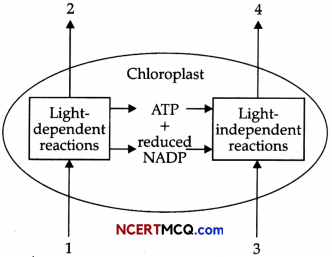
(a) What do labels 1 to 4 represent? (1)
(b) Name the products used to drive the dark reaction that is formed during the light reaction of photosynthesis. (1)
OR
The two parts of AT Pase enzyme are a headpiece and a stalk.
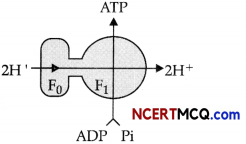
(a) State their arrangement in the thylakoid membrane. (1)
(b) Which part of the enzyme shows conformational changes? (1)
![]()
Question 3.
Many discoveries in science have been accidental. This is true for plant hormones also. Can you justify this statement by giving an example?
Question 4.
The diagram below shows a nephron of the mammalian kidney.
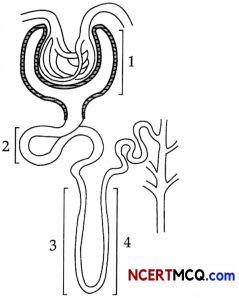
(a) Which among the regions (marked as 1,2,3 and 4) is the main region responsible for restoring the metabolic level of the blood plasma to its pre- renal level? (1)
(b) What is the role of Henle’s loop? (1)
Question 5.
In the human heart, blood from the lungs enter the heart through the left atrium, pumps into the left ventricle, out the aorta and through the body, and then returns into the right atrium, pumps into the right ventricle and exits to the lungs.
Name the labels marked from 1 to 5 in the below diagram and by using the labels, Explain the process of blood flow in humans in a sequential manner.
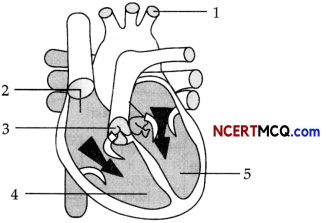
![]()
Question 6.
In a urine sample of a person, increased content of glucose and ketone bodies was found.
(a) Name the hormone and gland associated with this condition. (1)
(b) Name the condition. How can it be rectified? (1)
OR
In humans, blood calcium levels are maintained because the bones act as a calcium sink in which calcium can either be stored or procured based on the body’s needs.
(a) If a person secretes too much of parathyroid hormone (one possible factor in the bone disease osteoporosis), what happens to calcium levels in the body? (1)
(b) Mention one parathyroid disorder. (1)
Section – B
(3 Marks)
Question 7.
The diagram below explain the mitochondrial ETS.
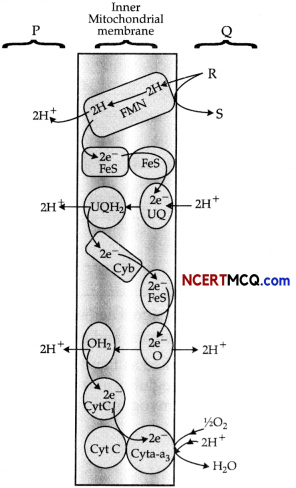
(a) Expand and define the term ETS. (1)
(b) Identify F, Q, R, S in the diagram. (1)
(c) Why oxygen is the ultimate acceptor of electrons in ETS? (1)
![]()
Question 8.
During the process of glycolysis, glucose goes through partial oxidation for the formation of pyruvic acid (2 molecules). It is obtained from the sucrose in plants which is the resulting product of photosynthesis. Invertase converts sucrose into fructose and glucose, which enter into the glycolytic pathway. These are phosphorylated to produce glucose-6-phosphate which isomerizes to generate fructose-6-phosphate. A sequence of 10 reactions regulated by different enzymes occurs in glycolysis to yield pyruvate from glucose.
(a) State where it occurs and its end products. (1)
(b) In both aerobic and anaerobic respiration, determine the fate of these products. (2)
OR
Study the figure carefully showing major pathway of anaerobic respiration.
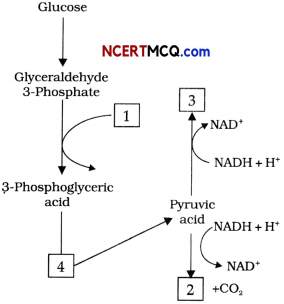
(a) Identify 1,2,3 and 4 in the given flow chart. (2)
(b) What is another name of Glycolysis? Where does it occur? (1)
![]()
Question 9.
Study the given diagram of synapse carefully.

(a) Identify the structure which transmits signal across a chemical synapse.
(b) State any two differences between chemical and electrical transmission.
Question 10.
Aashi was given sample of two muscles marked as 1 and 2. When she compared the muscles, she found that muscle 1 contains large amount of myoglobin and utilise large amount of stored oxygen for ATP production whereas muscle 2 contains few myoglobin, mitochondria and high sarcoplasmic reticulum.
(a) Identify the muscle 1 and 2.
(b) What is the function of myoglobin?
(c) What kind of muscle fibres form the extensor muscle on the back of human body? How do these fibres help?
![]()
Question 11.
In humans, the mechanism of breathing involves two stages i.e., Inspiration and expiration. The inspiration is an active process as it requires expenditure of energy for muscle contraction. During inspiration, the diaphragm and external intercostal muscle contract simultaneously. The expiration is a passive process as it does not require the expenditure of energy. In normal breathing, there are about 12 – 16 complete respiratory cycles per minute.
(a) Mention the main parts involved in initiating a pressure gradient between the lungs and the atmosphere during normal respiration. (1)
(b) State the volume of air remaining in the lungs after a normal breathing. (2)
Question 12.
The diagram alongside represents the circulation of blood in human body. Answer the questions that follow:
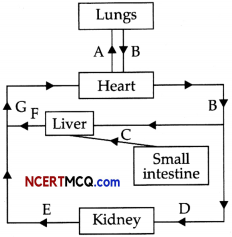
(a) Name the blood vessels labelled A, C, F and G. (1)
(b) Name the blood vessel that supplies the walls of the heart with oxygen. (1)
(c) Mention one structural difference between blood vessels represented D and E. (1)
![]()
Section – C
(5 Marks)
Question 13.
While examining the mitotic stage in a tissue, one finds some cells with 16 chromosomes and some with 32 chromosomes.
(a) What possible reasons could you assign to this difference in chromosome number? Do you think cells with 16 chromosomes could have arisen from cells with 32 chromosomes or vice versa? (3)
(b) The following events occur during the various phases of the cell cycle. Name the phase against each of the events.
(i) Disintegration of nuclear membrane __________
(ii) Appearance of nucleolus __________
(iii) Division of centromere __________
(iv) Replication of DNA __________ (2)
OR
Shown below are four stages (A, B, C, D) (not in sequence) of a certain kind of cell division.
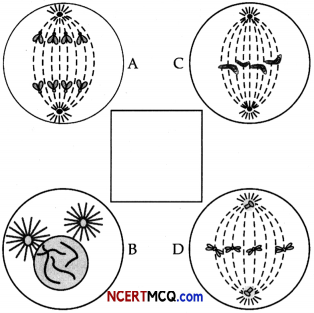
![]()
(a) Is the given cells undergoing mitosis or meiosis? (1)
(b) What should be the correct sequence of these four stages among themselves? (1)
(c) Name the stage that should precede the earliest of these stages. (1)
(d) Draw the stage named above inside the blank space provided. (2)